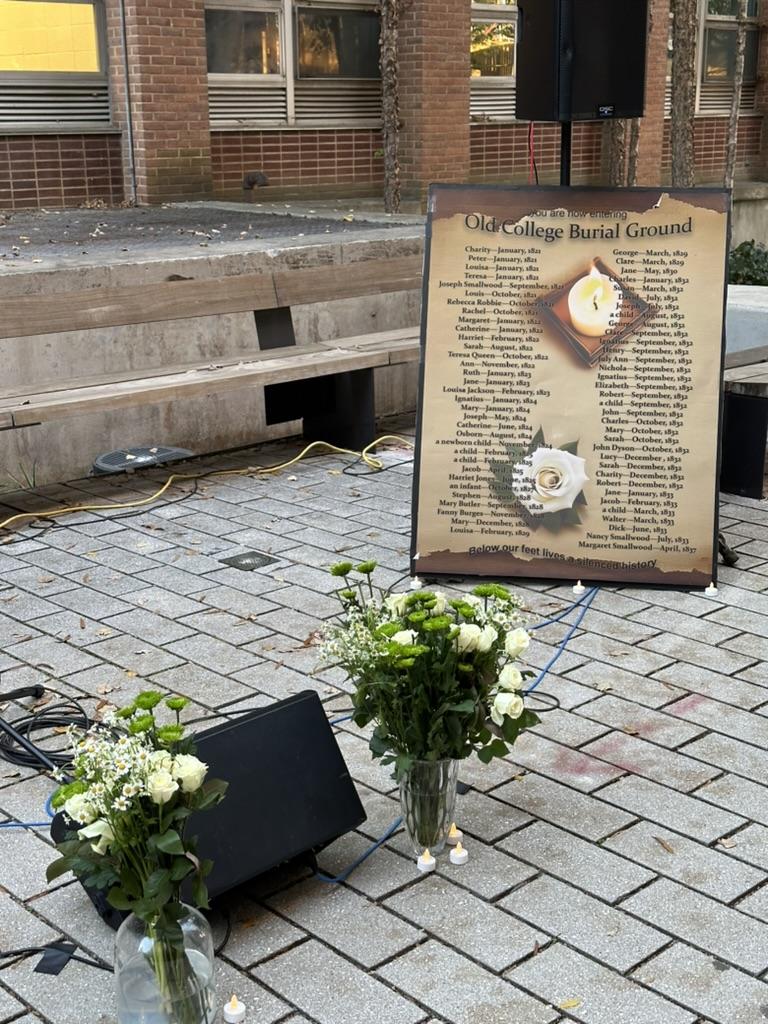Hoyas Advocating for Slavery Accountability (HASA) held a libation ceremony Nov. 5 to honor the unrecognized victims of enslavement whose unpaid labor built Georgetown University.
The event was held on the steps of the Reiss Science Building, which lies on top of a graveyard of former enslaved individuals. HASA chose a libation of water, the process of pouring out a liquid in honor of a deity, to symbolize purity and remembrance, resembling how many enslaved people traveled across the Atlantic Ocean to reach the Americas. During the libation, students placed flowers around a tree across from Reiss to symbolize purity and life and to honor enslaved people’s role in building modern-day Georgetown and the Americas.
Tristan Porter, a descendant of the Queen family, one of the enslaved persons sold by Georgetown University, said HASA chose a libation ceremony to acknowledge the social death of enslaved persons’ traditions, culture and spirit by white colonial actors. The libation is a way to respect African cultures that colonizers demonized upon enslaved peoples’ arrival in the Americas.
Several speakers before the ceremony highlighted the historical importance of the libation, including Mélisande Short-Colomb, descendant of the Queen family; Lisa Fager, executive director of the Black Georgetown Foundation; Malachi Robinson, a filmmaker and descendant of the GU272+; and Jordan Curls, a singer-songwriter who performed at the event.
The Jesuits of Maryland, who operated Georgetown University, sold 314 enslaved people, known as the GU272+, in 1838 to pay off university debt. The land over the Reiss building and the neighboring Pedro Arrupe, S.J. Hall served as a Catholic cemetery for enslaved people in the Georgetown neighborhood from 1818 to 1833. Construction of Arrupe Hall in 2014 revealed a human thigh bone, sparking outrage that the university did not properly care for the land before building.
Porter said Georgetown is inseparable from the institution of slavery, especially as students walk across the grounds of the buried every day.
“The bad of an institution isn’t something that has to be permanent, but you have to admit your mistakes, acknowledge your mistakes and take the steps to rectify your mistakes,” Porter said at the event. “We are here to call on Georgetown to do not only the things that it said it was going to do, but also to do more because it can do more and it should do more.”
Fager oversees the Black Georgetown Foundation, which seeks to preserve Mt. Zion and Female Union Band Society Cemeteries, both historically Black.
These cemeteries are the final resting place to 8,000 to 10,000 free and enslaved Black people, including ancestors and descendants of those who were enslaved at Georgetown, according to Fager.
“It’s not enough to just say their names anymore. We need to find research and share their stories,” Fager said at the event. “They are not just names. They are amazing, enduring, resilient, brilliant, innovative and loving people who made a way when there was no hope. We can learn from their struggle as we endure our own. We must connect the dots not just inside these walls but beyond.”
Robinson said that he hopes to honor the legacy of the GU272+ through an upcoming documentary film he began making after discovering he was a descendant. While Robinson said he does not consider himself a documentary filmmaker, he said learning about his own ancestry called him to share that history with others.
“That is my purpose that has been put on top of me by my ancestors, and they’re not letting me finish until I see the finish line,” Robinson said at the event. “It is up to us to keep their memories alive.”
Short-Colomb said that the GU272+ are the involuntary founders of Georgetown and America as a whole. Short-Colomb added that while the Black population is often shoved to the margins of American life, they are a crucial part of its fabric.
“For hundreds of years, we have chosen to relegate Black people to the margins of life here in America, but we’re not a minority,” Short-Colomb said at the event. “We’re just like everyone else here.”
Short-Colomb added that the education that Georgetown students receive is owed in part to these enslaved people — and there must be mechanisms in place to ensure all community members know about the history of enslavement.
“We have our work to do, and it requires you to decide every single day who you’re gonna show up for and who you’re gonna show up as,” Short-Colomb said.















